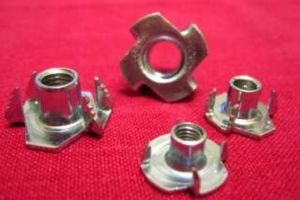When it comes to securing components in woodworking, furniture assembly, or other DIY projects, T nuts are invaluable. However, choosing the right size of T nut for your application is crucial for ensuring a secure and stable connection. In this guide, we'll explore the factors to consider when selecting the appropriate size of T nut, focusing on the popular sizes M8 and M10, and how to determine which one is best suited for your needs.
Understanding T Nuts
T nuts, also known as tee nuts or blind nuts, are threaded inserts with a flange that resembles the letter "T" when viewed from above. They are commonly used to create a threaded anchor point in materials like wood, plastic, or composite boards. T nuts are inserted into a pre-drilled hole and secured by tightening a bolt or screw into the threaded portion. They should be fitted to the top of the sheet material, so as to flat is upward then it will produce a secure fitting. They should not be fitted to the underside of the material.
Factors to Consider When Choosing T Nut Size
- Thread Size: The thread size of a T nut refers to the diameter of the internal threading. Common thread sizes include M8 (8mm diameter) and M10 (10mm diameter). Choosing the appropriate thread size is essential for compatibility with the corresponding bolt or screw.
- Material Thickness: Consider the thickness of the material into which the T nut will be inserted. Ensure that the length of the threaded portion of the T nut is sufficient to penetrate the material fully without protruding on the other side.
- Load Requirements: Evaluate the load-bearing capacity and strength requirements of your application. Larger diameter T nuts, such as M10, offer increased load-bearing capacity compared to smaller sizes like M8 and may be more suitable for heavy-duty applications.
- Compatibility with Hardware: Ensure compatibility between the chosen T nut size and the accompanying bolts, screws, or threaded inserts. M8 T nuts require M8 bolts or screws, while M10 T nuts require M10 hardware.
Choosing Between M8 and M10 T Nuts
- M8 T Nut: Ideal for applications where space is limited or where lighter loads are anticipated. Suitable for furniture assembly, cabinetry, and light-duty woodworking projects.
- M10 T Nut: Offers increased strength and load-bearing capacity compared to M8 T nuts. Suitable for heavy-duty applications, such as construction, machinery assembly, and structural installations.
Conclusion
Selecting the right size of T nut, whether M8 or M10, is essential for ensuring a secure and stable connection in your projects. Consider factors such as thread size, material thickness, load requirements, and compatibility with hardware when making your decision. For a wide selection of high-quality T nuts in various sizes, visit Castors-Online.co.uk and find the perfect solution for your application.










